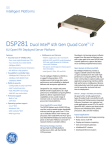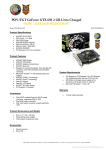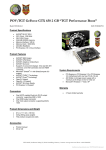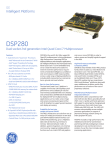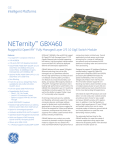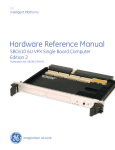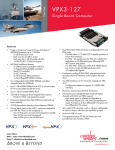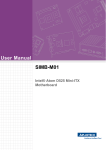Download GE DSP283 Brochure
Transcript
GE Intelligent Platforms High Performance Embedded Computing introduction Parallelism has been at the heart of supercomputing since the term was first used in the 1960s. Today, supercomputing has, in many instances, become high performance computing but instead of vast rooms full of mainframe computers all working together on the same problem, high performance computing sees the deployment of numbers of server-class machines, each featuring multiple high p erformance processors configured in parallel. And now, high performance computing has come to the world of embedded systems – and, especially, to the systems being developed and deployed by the world’s armed forces. To address the most demanding and sophisticated applications, such as ISR and electronic warfare, high performance embedded computing – HPEC – uses the power, not just of multiple single board computers working together, but also of multi-core and many-core processors. Unique challenges But HPEC in the military arena presents a unique set of challenges in two key areas as a result of how and where these solutions will be deployed. The first of these is the need to ensure 100% reliability – in what are often, literally, life-and-death situations – in the face of extremes of shock, vibration, temperature and contaminants. The second is that, increasingly, these solutions are being deployed in environments that are small, and that need to minimize weight, power and heat. Both are fields in which GE Intelligent Platforms is an acknowledged leader. No other company has GE’s pedigree in the devel- GE’s HPEC Center of Excellence GE has established a High Performance Embedded Computing Center of Excellence (CoE) specifically to support customer demand for high TRL (technology readiness level) COTS (commercial off-the-shelf) solutions that can shorten time-to-market, minimize cost and help to eliminate program risk, allowing prime contractors, system integrators and OEMs to focus on value-add and create competitive advantage. The Center takes advantage of GE’s COTS Rugged Systems (CRS) capability to support the rapid deployment of systems to the field. The HPEC CoE also provides a focus for the future development of a range of powerful, flexible products and solutions for military/aerospace embedded computing. 02 h i g h perfo rman ce embedded compu t ing opment of systems that are truly rugged, capable of withstanding the rigors of deployment in the harshest environments. And no other company is able to better GE’s expertise in developing HPEC solutions that are small, lightweight, consume minimal power and dissipate minimal heat. GE is well-known for its ability to develop and deliver leading-edge single board computers, multiprocessors, high speed switches and so on. Much less well known is GE’s ability as a systems company, able to provide complete, rugged, ready-to-run subsystems – and a broad range of supporting services. Meeting new realities It’s not just about hardware. In an era of acquisition reform, without the luxury of extended, government-funded development cycles, the onus on development exists with the supplier. To meet these new realities, GE provides a complete development environment – AXIS – that reduces development time and cost and accelerates time to market. There’s more to GE’s HPEC offering than just hardware and software, however. GE also has an unmatched understanding of, and commitment to, long term support – recognition of the multi-year (multi-decade, even) lifecycle of the typical military program. That understanding and commitment is backed by one of the world’s most respected, most secure companies. GE Intelligent Platforms has been a long time champion of COTS – commercial of-the-shelf – solutions, because of what they bring to customers in terms of faster access to new technologies, high technology readiness levels (TRL), ease of interoperability through the use of open standards, reduced program risk and lower lifetime cost of ownership. Today, GE readily works with customers to create custom variants of those solutions – variants that combine the advantages of COTS with the benefits of custom development. GE is in the business of developing innovative solutions all the time, every time – for the long term. In an unpredictable world, only a company of GE’s size, stature, resources and experience can work with customers to anticipate needs – and minimize the impact of the unforeseen. At the heart of everything GE does is the deep understanding of what is most important to customers: bringing value-added, differentiated, high performance, reliable and cost-effective solutions to market in the fastest time, at the lowest cost and with the minimum of risk – thereby creating competitive advantage. GE knows that this goal is only achieved through a mutual investment in the relationship and a shared commitment to success. d ef en s e .ge - i p.co m / hp e c 03 software Overarching GE’s comprehensive high performance embedded computing offering is AXIS, an integrated, sophisticated yet easy to use software development environment that has led to software development time being halved, and to software testing beginning 30% sooner than would have been achieved with a ‘hand-crafted’ solution. AXIS reduces the time taken to develop, test, debug and optimize complex DSP software applications based on multiprocessor platforms. Because of the high level of hardware abstraction it provides, it requires little or no developer knowledge of the underlying platform, freeing developers to focus on the application. As such, it reduces program risk; it increases productivity; it reduces costs; and it reduces time-to-market, creating competitive advantage. Easy, fast, cost-effective Not only this: AXIS is highly portable, allowing the easy, fast and cost-effective migration of a software solution to multiple hardware platforms as well as simplifying technology insertion during the lifetime of a program. AXIS provides support for GE’s latest multicore and many-core hardware platforms including single board computers featuring 4th Generation Intel® Core™ i7 processors as well as those featuring the latest Power Architecture processors from Freescale, and those featuring NVIDIA’s CUDA GPGPU (general purpose processing on graphics processing units) technology, providing customers with a highly integrated hard- ware and software platform that uniquely enables them to take maximum advantage of the enormous benefits of the latest processing technologies. Tuning to meet performance requirements The AXISPro software suite includes an integrated graphical user interface. AXISView provides tools for application development and system visualization. The developer exploits an iterative application development cycle allowing the user to benchmark routines and tune the application to meet performance requirements. In addition, AXISFlow provides a high performance interprocessor communication library for high throughput , low latency data movement across multiple fabrics (PCI Express®, Gigabit Ethernet , 10 Gigabit Ethernet , InfiniBand and Serial RapidIO etc.) scaling from one to many CPU cores and nodes across a single board, multiple boards in and multiple system chassis. If open standards are required, then AXISmpi offers an embedded computing focused MPI library that will operate across heterogeneous systems. AXISLib provides DSP and math function libraries to support very high performance signal and data processing routines with a standard VSIPL interface as well as a faster proprietary API for optimum performance and portability across multiple processor platforms. Generic C versions of the libraries are also available. As well as support for OpenVPX, AXIS provides support for VME and VXS systems. Software: The GE Advantage 6High performance, low overhead RDMA capability using AXISFlow and OFED software stack. 6Open standard VSIPL and MPI support. 6AXISView GUI enables system visualization and rapid prototyping. 6Signal processing algorithm optimization services. 04 h i g h perfo rman ce embedde d compu t ing TO FIND OUT MORE: http://defense.ge-ip.com/products/axis-multiprocessing-software/c153 d ef en s e .ge - i p.co m / hp e c 05 solutions Few, if any, embedded computing companies can offer the range of HPEC solutions that are available from GE Intelligent Platforms. In line with GE’s strategy of enabling customers to enjoy – and maximize – the benefits that accrue from COTS solutions, all of GE’s HPEC offerings are built around technologies that are industry standards and that represent ‘best in class’. Demanding military applications Processors come from Intel®, with its industry-leading second generation Core dual- and quad-core technology, and from Freescale, a long time significant contributor to embedded computing. From NVIDIA comes its CUDA architecture and many-core GPU (graphic processing unit) processors – not just for graphics applications, but also for general purpose use in the most demanding military applications that can benefit from a high degree of parallelism, such as radar. From Mellanox comes InfiniBand and 10 Gigabit Ethernet, switched fabric communications links used extensively in high performance computing and enterprise data centers. As part of its unwavering commitment to open industry standards, GE also supports OpenVPX, an architecture framework that defines system-level VPX interoperability. Specifically developed for deployment in rugged environments, it is the natural heir to VME, the computer bus standard that has been at the heart of embedded computing since the 1980s, and which GE also supports, along with the CompactPCI industry standard. Support for industry standards Along with hardware and technology standards, GE’s range of HPEC solutions also support industry software standards, such as Microsoft Windows and Linux, along with industry standard real-time operating systems such as VxWorks from Wind River Systems, Integrity from Green Hills Software and LynxOS and LinuxWorks. Software support also comes in the form of AXIS, GE’s Advanced Multiprocessor Integrated Software development environment which has been shown to substantially 06 h i g h perfo rman ce embedded compu t ing Ground Vehicle Applications Network Switch Units Target Tracking Embedded Training Integrated Display Processing SBCs, DSPs, Graphics, I/O Cards Situational Awareness Remote Interface Units Launcher Control Units Fire Control Computers Hull/Turret Compters Embedded Rugged Systems Mission Control Flight Control Sensor Processing Vehicle Management shorten the development, debug and optimization cycle. The OFED software stack from the Open Fabric Alliance is also fully supported, providing drivers and open standards interfaces along with RDMA-enabled communications protocols such as OpenMPI, uDAPL and sockets direct. This allows developers to leverage the extensive landscape of commercial HPC software. Extensive HPEC offering GE’s extensive HPEC offering includes single board computers such as the SBC626, Based on the high performance fourth generation Intel Core i7 processor, it features fully integrated graphics and memory controller together with dual or quad core processing up to 2.4 GHz and offers outstanding performance per watt. Coupled with the Intel QM87 chipset, this provides an unmatched level of I/O bandwidth for both on-board and offboard functions. Naval Applications Aerospace Applications Remote Interface Units Network Switch Units Radar Warning Receivers Stores Management Computer Integrated Display Processing SBCs, DSPs, Graphics, I/O Cards Mission Management Computers Navigational Control Units IFF Controllers Flight Management Computer Integrated Display Units Communications and IFF Shipboard Network Control Target Detection & Tracking Fire Control Computers Sensor Processing Switches, subsystems and more The other key members of GE HPEC solution set are the GBX460 10Gigabit Ethernet and the IBX400 InfiniBand 6U OpenVPX switch fabric modules (SFMs). s sonar, image and sensor processing across a wide range of platforms including manned, unmanned airborne, ground and naval vehicles. Multiple DSP281s can be interconnected via InfiniBand or 10 Gigabit Ethernet fabric switches to create powerful HPEC clusters. GE’s DSP281 is the latest in a long line of multiprocessors designed for the most demanding ISR applications. Like the SBC626, it is based on Intel second generation Core processor technology – but features a dual quad core architecture, delivering, in effect, eight CPU cores on a single board and making it ideal for demanding DSP, radar, The IPN251 provides over 750 GFLOPS of combined CPU and GPU compute power. They can be built into a multi-board clusters providing TERAFLOPS of processing power. For applications that demand an even higher degree of parallelism, GE has introduced the IPN251 platform. Each is based around the NVIDIA CUDA GK107 GPU, with its 384 cores. In the case of the IPN251, the GK107 is augmented by an Intel Core i7 processor operating at 2.4 GHz to create a heterogeneous and computationally-dense processing platform for demanding applications that are constrained in terms of size, weight and power (SWaP). Solutions: The GE Advantage CoE helps with architecture definition, application development and performance optimization 6Able to deliver short lead time software development platforms with a path to fully ruggedized deployable systems 6Provide fully software integrated and tested ‘application ready’ solutions 6Provide ‘getting started’ support and training The NETernityTM GBX460 SFM is a fully managed layer 2/3+ Ethernet switch supporting up to sixteen payload slots via 10GE data plane (DP) at up to wire speed along with full control plane(CP) GbE connectivity. Alternatively, system architects can benefit from increased bandwidth and reduced latencies by selecting the IBX400 SFM that is slot compatible with the GBX460 platform. IBX400 can support up to 16 pay load slots with double data rate (DDR) Infiniband providing up to 1.8GBytes/s throughput across the data plane along with the a fully managed GbE CP interface. Both solutions benefit from GE’s OFED RDMA enabled processor modules yielding unprecedented levels of performance within a standard 6U OpenVPX single or dual star system architecture scaling to multi-TeraFLOP parallel computing within fully rugged, deployable platform. The most recent addition to GE’s HPEC range is the rapidly-growing family of COTS Rugged Systems (CRS). Designed for customers who need to eliminate the expense, time and risk of custom sourcing and development, these preconfigured, pretested, ready-torun systems can be deployed in the field as soon as the application is ready, or used as a starting point for multiple application-specific configurations. 6HPEC GE’s comprehensive HPEC product and system offering is backed by an extensive infrastructure of customer support programs designed to ensure that high performance, reliable systems are deployed in the minimum time, at minimum cost and with minimum risk. d ef en s e .ge - i p.co m / hp e c 07 technology GE Intelligent Platforms has long been a leader in taking COTS – commercial off-the-shelf – technologies and adapting them for the rigorous requirements of military organizations around the world. COTS: faster access to technology, lower cost of ownership The advantages of COTS are many. COTS solutions allow military organizations to leverage the latest in commercial technologies far faster than would otherwise be the case. COTS solutions are significantly more cost-effective, because they obviate the need for extensive upfront investment in development – and they take advantage of technologies that are produced on a commercial scale. A COTS solution can typically be deployed more quickly, shortening time-to-market. Lifetime cost of ownership of a COTS solution is lower because the vendor takes responsibility for long term support – and COTS solutions are designed to ease technology insertion, maximizing performance over the lifetime of a program. Because COTS solutions are derived from commercially-proven technologies, they typically feature a high Technology Readiness Level (TRL) and minimize program risk. An example of the COTS paradigm in action is Intel’s range of processors, and notably its second generation Core processors. Within nine months of its announcement , Intel had shipped more than 75 million devices, widely implemented in servers, desktops and laptops – as well as in military embedded computing applications on platforms such as GE’s Intel Core i7-based SBC626 single board computer and DSP281 multiprocessor. Fourth generation Intel Core i7 processors bring unprecedented performance to a wide range of applications and, by integrating advanced graphics – and other – capabilities, enable high performance embedded computing solutions to be smaller, lighter, consume less power and dissipate less heat. 08 h i gh perfo rman ce emb e dded compu t ing GPGPU solves complex problems faster GPGPU – general purpose computing on a graphics processing unit – technology is an excellent example of how military organizations can leverage technologies originally designed for commercial and consumer applications. PC-based game playing has long driven advances in GPU technology as gamers strive for ever-greater realism – and that same search for enhanced realism has seen GPU technology widely deployed in military display applications such as embedded training. But the inherent high degree of parallelism that brings ultimate graphics performance can also be used to deliver other types of processing – types of processing widely required in military applications such as radar, where the requirement is to process multiple streams of data simultaneously. Customers using NVIDIA’s CUDA GPU architecture – such as the 384-core GK107 – for applications such as SAR simulation, pattern recognition, object detection and cryptography are reporting performance increases of between 10x and 500x. Using a GPU to augment the capability of a traditional CPU can therefore bring real size, weight and power (SWaP) advantages to high-end processing systems. Dual NVIDIA CUDA GK107 GPUs are featured in the GE Intelligent Platforms IPN251 multiprocessor, combining the power of a GK107 with the performance of a 3rd generation Intel i7 processor for maximum application integration and flexibility. The most demanding C4ISR and EW applications demand high performance embedded computing which sees the deployment of multiple processors of either homogeneous or heterogeneous types, either on a single silicon devices, on a single board – or on multiple boards. Serial switched fabrics for high system throughput This presents two key challenges. The first is in the intercommunication between the processors – but here too, GE provides solutions. GE was among the first embedded computing companies to commit wholeheartedly to the interconnect technology that has rapidly become the standard for demanding military applications. VPX – and, subsequently, OpenVPX – grew out of the pervasive and hugely successful VME standard, and is an open standard which utilizes the familiar 3U and 6U card sizes of VME. It offers true rugged capabilities, including conduction cooling and resistance to shock and vibration. At the same time, it offers higher power budgets, more signal density and a far faster serial backplane. GE has also chosen to standardize on two other open interconnect standards: 10 Gigabit Ethernet and InfiniBand. 10 Gigabit Ethernet was chosen not only for its high performance, but because it is ubiquitous, supported by a substantial ecosystem of products, technologies and expertise. Technology: The GE Advantage 6 100% commitment to COTS, industry standards in key technologies such as truly rugged GPGPU, InfiniBand 6 Leadership in ruggedization 6 Focus on compelling SWaP characteristics, high performance 6 Innovator The Intel/InfiniBand combination is dominant in the high performance computing clusters that are often called ‘server farms’ – installations which deliver massive computing power by coupling together multiple servers or blades. With the growing requirement in the military/aerospace market to gather, process and disseminate huge volumes of data, those server farms are increasingly being replicated in defense applications. For customers looking to create similar profiles, there are sound commercial as well as technical reasons why the Intel/InfiniBand combination is a compelling one. environment. AXIS is a set of software modules that can be used to accelerate the design, development, testing and deployment of complex DSP and multiprocessing platforms for real-time applications such as radar, sonar, communications and image processing. Software rises to the development challenge The second challenge is in managing the multi-faceted complexity of developing challenging, mission-critical applications on hardware platforms that can themselves be complex to master – and to do so in minimum time and at minimum cost. GE’s high performance embedded computing solutions combine the best in COTS technologies with open standards and advanced tools to make the development and deployment of demanding ISR applications easier, faster and more cost-effective. AXIS allows tough questions – about system sizing, data movement, algorithm performance, configuration, application mapping and so on – to be answered quickly and easily, speeding the cycle of design, development, test, optimization and validation and reducing time to market. Here, GE offers the AXIS – Advanced Multiprocessor Integrated Software – development d ef en s e.g e - i p.co m / hp e c 09 applications Radar Developers of today’s radars demand that their processing systems be founded upon the principles of Modular Open System Architecture. Designs must be scalable, open architecture and capable of sustainment for the long term with technology insertion plans. In response, GE has adopted OpenVPX as the primary form-factor, using widely adopted processors from Intel and NVIDIA, connecting processing clusters with standard interconnects like Ethernet and InfiniBand, and providing support for Linux, Open Fabrics Enterprise Distribution, MPI, DDS and so on. Signal Processing By using the rapid prototyping capabilities of AXISView along with quick implementation of radar algorithms with VSIPL and VSIPL++, a signal processing system can readily be modeled to determine how many processors are needed. GE can produce standard or custom radar backend processors scalable to dozens of TFLOPS. Such systems can extend from sensor input via standard interfaces such as serial FPDP and 10GbE, through processing on clusters of Intel processors with optional NVIDIA GPGPU co-processing, to output to a backend system via standard Gigabit Ethernet. Electronic Warfare Electronic Countermeasure Systems are typically defined by their need for low-latency processing. To date this has often required FPGAs to meet the latency constraints. Now, GPUs can be considered for such applications. GPUdirect allows sensor data to be transferred straight into GPU memory, bypassing the multiple copies and host processor involvement that were previously required. Testing has shown a reduction in latency of better than 25x, opening up the use of GPUs in applications that were previously not candidates. Development time and cost are also reduced. 10 h i g h perfo rman ce emb edded compu t ing Targeting Targeting pods require increasing processing power to keep up with increased sensor resolution and added sensors. Typically the system size is restricted by the existing pod profile and power. GE’s range of OpenVPX products, spread across 3U and 6U form factors allow for highly scalable solutions from the smallest to the largest pods. The AXIS software tools allow seamless scalability of the application to match the hardware. Gigabit and 10Gigabit Ethernet offer standard connections between subsystems and to sensor suites. ISR Visualization Increasing focal plane array size, faster frame rates and more sensors being fused mean that more capability is being demanded in the same or lower size, weight, and power. GPUs are particularly well suited to processing the large volumes of pixel data present on today’s ISR platforms. Given the shock and vibration levels that many ISR platforms are subjected to, GE’s policy of using chipdown designs fits well. The use of high speed fabrics with RDMA allows the sensor data to be efficiently spread to the processing nodes. 360 Degree Situational Awareness To acquire, convert, stitch and display video streams from multiple HD cameras requires considerable compute power. Typically these systems must be capable of being retrofitted into spaces on vehicles that offer severe restrictions on size and cooling paths. By offering a complete range of SBCs, GPUs, Manycore processors and network interfaces, GE can supply the building blocks for the most demanding of SA systems. The availability of middleware and application frameworks speeds the development of the solution. d ef en s e.g e - i p.co m / hp e c 11 product examples SBC626 6U OpenVPX 4 Gen Intel Core i7-based Single Board Computer th FEATURES 6 6U OpenVPX SBC 6 Quad core, 4th Gen Intel Core i7 processor @ up to 2.4 GHz 6 Intel QM87 Express Chipset 6 Up to 32 GB of DDR SDRAM w/ECC 6 Up to 32 GB NAND Flash 6 Dual on-board expansion sites (XMC/PMC) 6 Air and conduction cooled versions 6 Comprehensive Deployed Test Software 6 Comprehensive Operating System support 12 h i g h perfo rman ce embedde d compu t ing DSP281 IPN251 6U OpenVPX Deployed Server Platform 6U OpenVPX GPGPU Multiprocessor FEATURES Intel Core i7-4700EQ CPUs: –Four cores, eight threads per CPU –Two channels ECC 1600-DDR3L –16GBytes DDR3L, 32GB future option –AVX2.0 Advanced Vector Extensions –HD-4600 on-chip graphics 6 Two platform controller hubs: –16MBytes BIOS Flash per PCH –16GB SATA Nand Flash –512KB NVRAM 6 Platform Security: –Configurable Security Hub FPGA –Intel Trusted Execution –Intel vPRO / AMT technology –Intel AES new instructions 6 Firmware support: –Built-in Test –UEFI BIOS 6 Operating System Support: –Linux® SDK –Windows® SDK –WRS VxWorks® BSP –WRS Hypervisor 6 Middlewares and Libraries: –AXISPro application development framework –AXISLib VSIPL and RSPL multi threaded DSP and math libraries for VxWorks, Linux & Windows –GE signal- and image processing quick start examples –Intel OpenCL SDKs, IPP and MKL 6 Two FEATURES VPX: 6U rugged VITA46/VITA48 REDI/AFT –Multi-fabric data, expansion and control planes –2x 10 Gigabit Ethernet/InfiniBand –x16 PCIe Gen 2 –4x 1-Gigabit Ethernet 6 CPU: 3rd Gen Intel Core i7 6 GPU: NVIDIA 384-core “Kepler” EXK107 6 XMC Site 6 Software –BIOS, Linux, Windows –NVIDIA CUDA, OpenCL, OpenGL –AXISLib-VSIPL Math & DSP libraries –NVIDIA PhysX –Matlab 6 Open IBX400 GBX460 SCVPX6U-95 series 6U OpenVPX InfiniBand Switch Fabric Module OpenVPX Fully Managed Layer 2/3 10 GigE Switch Module HPEC Application Ready Platforms FEATURES 6 6U OpenVPX VITA65 Switch Profile –SLT-SWH-16U20F-10.4.2 –MOD6-SWH-16U20F-12.4.2-10 6 DDR InfiniBand Data Plane –20 x Fat Pipes –High throughput, low latency –In-band subnet management 6 Gigabit Ethernet Control Plane –16 x Ultra Thin Pipes –Fully managed layer 2/3 –Ethernet Switch Fabric 6 Management Plane –I2C/BMM Controller 6 OpenWare Control Plane Switch Management –Layer 2 and layer 3 packet switching –QoS Priority (IEEE802.1D) –IPv6 & IPv4 Switching 6 End to end RDMA solutions –6U OpenVPX SBCs, Multiprocessors, GPGPU blades and I/O 6 Application Ready Platforms –Fully integrated & tested Linux clusters for radar, image, signal and data processing FEATURES 6 6U OpenVPX Compliant: (VITA 65.0) 6 VITA 48 (REDI) 6 VITA 46.0-2007 (VPX Baseline Standard) 6 Switch Profile: SLT6-SWH-16U20F-10.4.2 Data Plane: 20 x 10GigE Ports Control Plane: 16 x 1 GbE Ports 6 Optional Profile: SLT6-SWH-24F-10.4.3 Data Plane: 24 x 10GigE Ports 6 Non-Blocking 6 Front I/O: Up to four 10GigE Fiber Ports available for slot profile SLT6-SWH16U20F-10.4.2 6 Full wire-speed 10GigE Performance 6 Ruggedization Build Levels: –Level 1, 2 & 3 Air Cooled –Level 4 & 5 Conduction Cooled –Level 8 Air Cooled VITA 48.5 6 RoHS 2002/95/EC Compliant 6 Based on high-performance Low Latency, Ethernet switch fabric from Fulcrum Microsystems 6 IEEE 802.3-2005 6 Option for Unmanaged operation 6 Hardware enabled IPv6 and IPv4 support 6 OpenWare Switch Management environment 6 Multi-cast Support: IGMP Snooping Querier and MLD Snooping Querier 6 Allows up to 4096 VLANS 6 L-3 Protocol support including OSPF, RIP and VRRP FEATURES 6 6U OpenVPX 5 slot lab development system 6 Single star BK6-CEN05-11.2.5-3 Backplane 6 Flexible configuration options with GE Processors and I/O 6 Supports 10GE or InfiniBand data plane 6 Fully integrated & tested Linux cluster with application examples CRS 48.5 Rugged VITA48.5 Subsystem FEATURES 6 6U OpenVPX 5 slot deployable system 6 Modular design supports 10GE or InfiniBand data plane 6 4 payload processor cards with SSD options 6 Fully integrated and tested Linux cluster with application examples d ef en s e .ge - i p.co m / hp e c 13 support GE’s Program Management (PM) service rigorously strives to eliminate the risk in HPEC program development and deployment. From development of the product requirements and program schedule to product qualification and release for production, GE works closely with its customers to demonstrate design and manufacturing progress as measured against the program baselines and forecasts. In the event that stock products cannot meet customer specifications, GE’s PM staff will develop a customer-centric plan to shepherd the product development from prototype to production. Price change risk is eliminated because GE’s initial quote remains the price until delivery. Reduction of risk and cost In addition, GE’s contract change management service reduces costly change orders by ensuring that every change has been formally approved by the customer and that a separate purchase order has been issued to reflect that change. The PM service also provides the documentation of risk management that contractors can provide to higher-tier contractors who want to know that systems will be delivered on time and exactly to specification. Effective Product Lifecycle management (PLM) ensures that parts are available to service routine and emergency maintenance – whatever the duration of the proposed deployment. A PLM program can also anticipate technology advances and thus allow for upgrades to embedded technology with a minimum of hardware or software disruption. The result is the highest level of repeatable performance at the lowest possible cost of ownership across a program’s lifecycle. GE’s long-established PLM team maintains close contact with component suppliers and industry groups such as the Component Obsolescence Group to constantly monitor technology developments and component obsolescence issues. 14 h i g h perfo rman ce embedded compu t ing Progressive and defensive long term support At the heart of the program is a dedication to providing both progressive and defensive long term support. ‘Progressive’ support begins on the design table, with embedded products being designed for maximum compatibility or upgradability even before they are qualified for a system. The list of critical components will include only those elements for which vendors have committed to a long-term production run. After a product is launched, ‘defensive’ PLM provides the technical support and service to keep the product running, as well as ensuring that sufficient stores of spare parts are available to avoid the premature shutdown of a system or even the entire platform. When technology obsolescence occurs in the marketplace, GE’s Health Check program will alert the customer and provide possible solutions such as a last-time buy of the components, an appropriate replacement component, a redesign of the original product for form, fit, or function compatibility, technology insertion earlier than planned or a lifetime purchase of the components. When components are purchased in bulk, GE also can provide secure, climate-controlled storage for as long as required by the customer. Long-term product lifecycles demand that critical engineering knowledge is available regardless of personnel changes or corporate restructures. Similarly, testing, diagnostic and repair capabilities must be maintained. GE Intelligent Platforms’ PLM program ensures that such knowledge, protocols and capabilities are available throughout the lifecycle of any program. TO FIND OUT MORE: http://defense.ge-ip.com/support/embeddedsupport Support: The GE Advantage 6 Unrivaled expertise in support of multi-decade program deployments to specific customer needs 6 Makes significant contribution to lower lifetime cost-of-ownership 6 Range of support strategies help reduce risk 6 Tailored d ef en s e .ge - i p.co m / hp e c 15 GE Intelligent Platforms Contact Information Americas: 1 800 433 2682 or 1 434 978 5100 Global regional phone numbers are listed by location on our web site at defense.ge-ip.com/contact defense.ge-ip.com ©2014 General Electric Company. All Rights Reserved. *Trademark of GE Intelligent Platforms, Inc., a wholly-owned subsidiary of General Electric Company. All other brands, names or trademarks are property of their respective owners. Specifications are subject to change without notice. 12.14 GFA-1921B

















